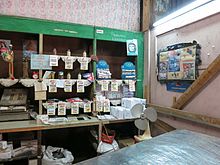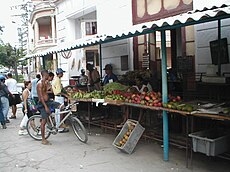Rationing in Cuba

Rationing in Cuba describes a system of distribution of food that is known in Cuba under the name Libreta de Abastecimiento ("reference booklet") or Libreta for short . This system determines the subscription quantities for each person and the frequency of allocation.
overview
The vast majority of Cuban families rely on the Libreta distribution system, which was set up on March 12, 1962 , for their grocery shopping . This system specifies in what quantity and how often certain things can be bought per person.
Most of these products are distributed through local stores called bodegas , which specialize in selling these rationed goods. For meat , poultry or fish , these are the appropriate butcher shops ( Carnicería ).
Some other industrial products are also available from Libreta , such as: B. tobacco products , fuel for stoves ( petroleum , heating oil , alcohol , kerosene or even charcoal - depending on the respective cooking options of the recipient), light bulbs and other household items.
The products included in the Libreta system vary depending on age and gender. For example, children under the age of seven receive one liter of milk per day, as do older, sick or pregnant women. People over 65 are also eligible for other awards. For special foods, a medical certificate must be presented that confirms the health problems and indicates which products are required because of them.
A government agency, the OFICODA (oficina de control de productos alimentarios - Office for the supervision of food products), which was created especially for this task, distributes the Libreta once a year to all residents in the form of a small booklet. This booklet contains pages with the exact number and age group of those who belong to a nuclear family. A notebook is usually assigned to a nuclear family, as are notes on possible diets. You can only purchase these goods in the bodegas responsible for the respective residential area . When moving, the data in the Libreta must first be rewritten in the OFICODA office.
Goods via the Libreta system are offered at subsidized prices. These have remained more or less stable since their introduction, although the average wage of a worker has hardly changed since then. There is a page for each month on which the seller notes which products and in what quantities. The libreta must be shown for every purchase in this regard.
When the rationing system was first introduced, it was not limited to food , but industrial products were also available. There was a booklet with coupons that could be torn off for the industrial products to be purchased. These were mainly clothes , shoes and housewares, as well as toys for children. Three different toys were usually approved per child per year and were usually offered before or during January 6th, the Feast of Epiphany (in Cuba: Día de los Reyes - Day of Kings ). After the collapse of the Soviet Union and the Eastern Bloc in 1989, the special period ( Periodo especial ) began in Cuba and industrial products were no longer sold through this system. Today, for example, fabric for sewing clothes and also finished garments are distributed via this supply system.
Special laws regulate the functioning of this system. Penalties are given for its abuse. The most frequent irregularities are agreements with the sellers that they do not enter the delivered goods or only incompletely in the ration booklet, or weigh incorrectly, etc. The Cubans can be held criminally responsible if they do not report changes in the composition of the family to OFICODA immediately.
Standard rations
The following table illustrates the standard rations as they are distributed through the Libreta . The stated amounts are per person and month. There is also an indication of the subsidized prices. The flat rates vary from year to year, so the numbers, based on data from 2000, can only give a rough idea:
| product | amount | Price ( CUP ) | |
|---|---|---|---|
| Arroz | rice | 6 lb (≈ 2.7 kg ) | 0.70 / lb |
| Granos | Beans | 20 oz. (≈ 567 g) | 0.32 / lb |
| Azúcar R. | White ( refined ) sugar | 3 lb (≈ 1.36 kg) | 0.15 / lb |
| Azúcar C. | Brown (unrefined) sugar | 3 lb | 0.10 / lb |
| Leche | Milk (children under 7 years old only) | 1 l / day | 0.25 / person |
| Huevos | Eggs (*) | 12 | 0.15 / person |
| Platanas | Potatoes / bananas | 15 lb (≈ 6.8 kg) | 0.40 / lb |
| (*) Only from September to December. (Source: https://web.archive.org/web/20100130075235/http://cubamigo.org/merengue123/alimentacion.html ) |
|||
Meat products, if available, are sold separately. There is a two-week cycle in which different products are usually sold alternately. Fish , beef , ground beef (usually mixed with soy ), poultry , sausage, and ham all fall into this category. Quantities and prices vary depending on the meat product: beef: half a pound per person, chicken: one pound per person; every two weeks.
It must be said that very often some goods are not available or their delivery is delayed. If, for example, no beans are available in a month, the missing amount is usually added to the following monthly amount. But this is not always the case. Such delays occur particularly with beef.
Since many goods are often not available in the bodega , long queues regularly form should these goods arrive more or less by chance. Accordingly, shopping often takes a long time. Therefore, some people with special needs, such as B. Pensioners or pregnant women have priority.
Justification of the government
According to the Cuban government, this method ensures the minimum supply of every inhabitant with food regardless of social or economic status and has published plans for its phasing out. However, specific dates for this were not given. It is also emphasized that the Libreta is not the only way for Cubans to purchase these products. They, as well as other goods were, also still available on free markets ( mercados libres ) or parallel markets ( mercados paralelos ) and of course in the many shops, the goods for convertible peso sell. It should be noted that the prices of products obtained through the rationing booklet are around twenty times lower than on the open market. It is also emphasized that the humanitarian aid that Cuba receives from other countries is distributed fairly and appropriately in this way. According to official attitudes, this system, while undesirable, is inevitable and fair.
The Cuban government recognizes that the rations distributed through the Libreta are insufficient to ensure a decent livelihood. The government also asserts that there is no political influence on the quantities purchased, i.e. every citizen, regardless of his or her political opinion or legal status, receives the same quantity of goods.
criticism
Critics question both the fairness and the purpose of this method. At the same time, they emphasize inadequacies, such as historical decline in delivery frequency and the available quantities of products. In their opinion, it creates deep economic differences within the Cuban people by dividing them into two parts: currency owners who can afford the higher prices in currency shops or mercados libres , and those who simply cannot.
The Cuban government is also accused of using this system to exert influence over the Cubans: the system of distribution of goods is the easiest, if not the only, way for most Cuban families to secure a minimal, poor standard of living (Salaries are usually paid in Cuban Pesos ). This gives the government the power to intimidate or punish dissidents who fear that they will be excluded from the libreta .
The critics also believe that humanitarian aid is not distributed through this system as the government claims. They also emphasize the fact that the system was established by the Cuban government in 1962 as a temporary response to a crisis but has been in place for 45 years.
In the Cuban population, criticism of the libreta with the help of the choteo has manifested itself in popular everyday expressions of Cuban Spanish .
Punish
In an international comparison, violations of food law are sometimes extremely severe. For example, under Cuban law, a person can get a higher prison sentence for killing a cow than for killing a human:
- According to Cuban criminal law, up to 10 years in prison are provided for killing a cow.
- Anyone who transports or sells meat from an illegally slaughtered cow can be sentenced to between three and eight years in prison.
- Anyone who offers unauthorized beef in a restaurant or at work faces two to five years in prison
- Buying such beef can result in imprisonment between three months and a year or a heavy fine.
The authorities have the right to confiscate all property of anyone involved in the black market trade in cattle.
See also
Web links
- Overview of Cuba's Food Rationing System (PDF; 567 kB) by José Alvarez, University of Florida
- Fernando Ravsberg: The Cuban Ration Book Turns 50 (English translation by Havana Times , Spanish original by BBC Mundo )
Individual evidence
- ↑ a b c Overview of Cuba's Food Rationing System José Alvarez University of Florida
- ↑ CANF: Con sólo tres productos se estrena la libreta de racionamiento de 2005
- ↑ Carta de Cuba - 22 de mayo de 2002 ( Memento of May 21, 2006 in the Internet Archive )
- ↑ Vladimiro Roca Antúnez: ¿Se puede vivir decorosamente con el salario promedio en Cuba? ( Memento of the original from May 18, 2006 in the Internet Archive ) Info: The archive link was inserted automatically and has not yet been checked. Please check the original and archive link according to the instructions and then remove this notice.
- ↑ Der Tagesspiegel of July 31, 2011: Satire against tyranny.
- ↑ Global Exchange.org: Drought and slaughter hurt Cuba's once-rich beef, milk industries ( Memento of April 6, 2009 in the Internet Archive )


